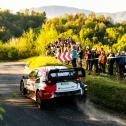Pressekontakt
ADAC e.V.
Oliver Runschke
Motorsport- und Klassik-Kommunikation
Tel.: +49 89 7676 6965
Mobil: +49 171 555 6236
E-Mail: oliver.runschke@adac.de
Kay-Oliver Langendorff
Leiter Partnerschaften, Kooperationen & Sponsoring
Leiter Kommunikation Motorsport & Klassik
Tel.: +49 (0)89-7676 6936
Mobil: +49 (0)171-555 5936
E-Mail: kay.langendorff@adac.de
12.10.2023 - Central European Rallye
Safety first: Comprehensive safety concept at the Central European Rally
- Sophisticated safety measures for the Central European Rally have been one year in the planning
- Spectators requested to do their bit to help the safety efforts
- Stages erected one week ahead of the rally
Rallying takes place on an open stage – and the newest round on the WRC calendar, the pinnacle of this spectacular sport, is no different. To ensure the action at the Central European Rally (26th to 29th October) is safe for all involved, a large and international team has been working for the last year on a safety concept for the 18 special stages and along the 1,650-kilometre route. In order to put all the countless details into practice, Andreas Spannbauer, head of route safety, can rely on a team of almost 2,500 people to undertake everything necessary to make the event as safe as possible for spectators, competitors and volunteers. However, unlike at permanent racetracks, the cooperation of spectators is traditionally particularly important at rallies. Their behaviour is instrumental in implementing the concept and allowing the event to run as smoothly as possible.
Rallies are held on routes that are otherwise used by normal road traffic. To enjoy a safe rally on these roads – naturally with special permission from the authorities – everyone must do their bit. “A rally cannot take place without responsible spectators,” says Andreas Spannbauer, head of route safety. For example, rally fans who enter specified restricted zones or loiter in other unsafe positions can cause a stage to be delayed and even cancelled. As such, the rallying cry to all fans is: behave responsibly as individuals, to ensure that the rally runs smoothly for everyone. As well as using designated spectator zones, this also includes consciously selecting safe locations everywhere – for example, in raised positions away from dangerous areas and a safe distance from the route. Particular no-go areas include the outside of corners and the funnel-shaped area behind crests.
Visitors are also requested to preserve the rally culture
Time and again, there are fans who deliberately seek out positions away from spectator areas. However, the urgent appeal from the organisers is to adhere to rules, in order to enjoy the spectacular WRC Show to the full. “A rally takes place in open terrain,” says Andreas Spannbauer. “Our request to all visitors is to use the designated spectator zones. We put a lot of effort into setting these up, in order to ensure people are able to enjoy the rally as much as possible in a safe and comfortable environment.” And it goes without saying that the spectator areas are not only in the interest of visitors. For example, protected biotopes are avoided and spectators are directed in a manner that causes as little disruption as possible to residents. Last but not least, anyone buying a ticket is also financing part of the rally. For the organisers, a WRC event involves a huge amount of effort and expense. By purchasing a ticket, visitors are ultimately acting fairly towards the organisers and all those fans who have bought their tickets.
One year’s preparation for a safe rally
The specialists responsible for route safety at the Central European Rally have been busy preparing since early autumn 2022. This is when it became apparent that the former ADAC 3 Cities Rally could be a candidate for a WRC event, together with its partners in Austria and the Czech Republic. It was also at this time that initial contact with the FIA experts responsible yielded information and allowed the organisers to set an early course for the concept now in place. This was then refined by a small team, in close cooperation with the FIA, and the concept is now approaching the acid test. “We are well prepared,” says head of route safety, Andreas Spannbauer, confidently. “The concept has received the blessing of all involved, the team and helpers are ready, now all we have to do is implement it at the event.”
Spectator areas offer safety and the best possible views
Implementing the concept for the Central European Rally requires a large number of helpers, lots of material for cordoning off areas and signposting, as well as detailed plans. They allow the teams on site to erect the stages properly: all restricted zones are indicated as such, spectator zones are marked out and dangerous areas are made even safer – for example, with one of the many bales of straw used. In the end, the competitors find routes that are up to competition standard, while fans can expect to find well-prepared spectator areas. To this end, for example, 34 kilometres of yellow barrier fencing is erected as mobile cordons for spectator zones, while an additional 80 kilometres of barrier tape is used. “A mammoth task! We start erecting the stages the weekend before the rally,” says Andreas Spannbauer. “The local clubs are particularly helpful. They get stuck in with setting things up, as well as running the spectator areas later.” When selecting these zones, several factors were important: the spectators must be as safe as possible in them, have a good view, and be able to experience as much of the action as possible. Of course, those in charge check several times whilst setting up that the plans are being adhered to, there is sufficient material, and that safety is guaranteed. Finally, the so-called ‘safety cars’ drive the stages shortly before the actual rally field. Working independently within this convoy, the deputy head of route safety, the FIA safety delegate, and a medical officer check that all the plans have been implemented and give their okay.
